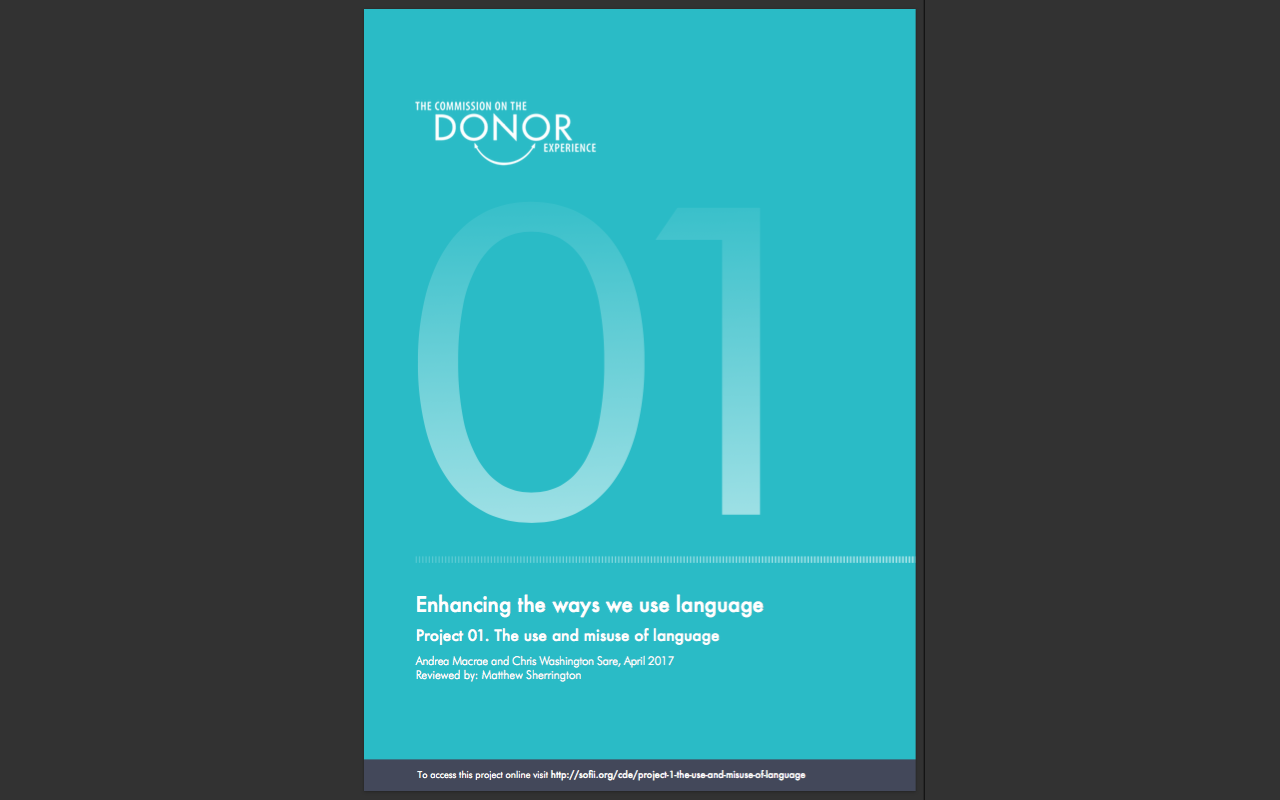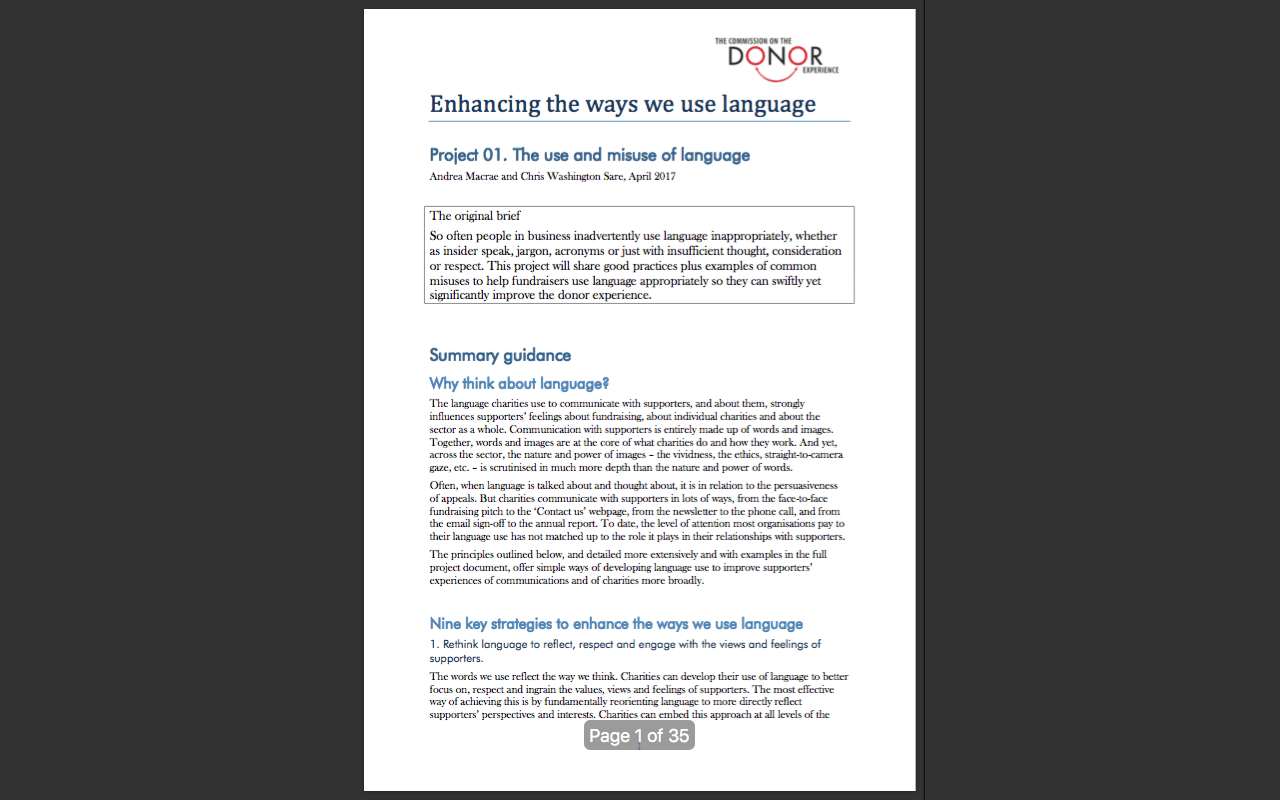CDE project 1 section 10: appendices
- Written by
- The Commission on the Donor Experience
- Added
- April 22, 2017
Enhancing the ways we use language
Andrea Macrae and Chris Washington Sare, April 2017
Reviewed by Matthew Sherrington
Appendix 1. Case studies
Most of the case studies are examples of current practice drawn from information in the public domain (such as websites) or from research interviews with charities. Any information within these case studies which was not already in the public domain has been shared with the kind permission of those charities involved.
1. Rethink language to reflect, respect and engage with the views and feelings of supporters.
Case study: Save the Children’s supporter focus
2. Talk less about the charity and more about the cause, the work, the beneficiaries and the supporters.
Case study: Cancer Research UK
3. Communicate authentic content with honesty.
Case study: The authenticity of UNICEF’s ambassadors
Case study: Misleading copy recycling
4. Communicate values, and do it consistently.
Case study: Perfect pitch: Linking voice and values, http://www.charitycomms.org.uk/articles/pitch-perfect-linking-voice-and-values
Case study: The ‘About us’ page; the Sumatran Orangutan Society, https://www.orangutans-sos.org/who-we-are *
5. Subvert expectations.
Case study: OXFAM’s ‘Pile of poo’
Case study: The NSPCC’s ‘Talking PANTS’ campaign, https://www.nspcc.org.uk/preventing-abuse/keeping-children-safe/underwear-rule/
Case study: Depaul UK’s ‘There’s another side to the story’ awareness raising campaign, http://publicis.london/made/corners/, https://uk.depaulcharity.org/our-work/our-campaigns
6. Use inclusive, accessible language, and void jargon.
Case study: Annual Reports – Keech Hospice Care 2105, see https://www.keech.org.uk/about/annual-reports**
Case study: Charity research publications - The Children’s Society ‘The Good Childhood Report’ 2016, http://www.childrenssociety.or...
Case study: Direct mail appeals
7. Invite feedback and turn it into dialogue.
Case study: The supporter’s voice at UNICEF
Case study: SolarAid’s simple questions
Case study: The Children’s Society acts on supporter feedback
Case study: Friends of the Earth engages with supporter concerns
8. Make contact permissions options work for supporters.
Case study: Opting in in the face-to-face fundraising scenario
9. Test your communications to find out what works best for your charity and your supporters.
Case study: Testing at UNICEF * with thanks to Matthew Sherrington for this point; **with thanks to Chris Washington-Sare for the example
Appendix 2. Research sources
Alongside research interviews with various senior figures in fundraising, supporter engagement, and charity consultancy services, the following documents and sources were used.
Bennett, R. (2009), ‘Factors influencing donation switching behaviour among charity supporters: An empirical investigation’, Journal of Customer Behaviour, vol. 8, issue 4, pp. 329-345.
Berman, B. (2005), ‘How to delight your customers’, California Management Review, vol. 48, issue 1, pp. 129-151.
British National Corpus, http://www.natcorp.ox.ac.uk/
Burnett, K. (2016), ‘Would you live next door to a lapsed donor?’ http://www.kenburnett.com/Blog63whodbealapseddonor.html
Burnett, K. (2014), ‘Communication and the English language: How staleness of imagery and lack of verbal precision hold fundraising back’ http://www.kenburnett.com/Blog...
Charity Commission. (2016), Public trust and confidence in charities report. Research conducted by Populus.
Cole, D. (2016), A guide to creating charity permission statements, published by fast.MAP and the Institute of Fundraising.
Cotte, J., Coulter, R. A. & Moore, M. (2005), ‘Enhancing and disrupting guilt: The role of ad credibility and perceived manipulative intent’, Journal of Business Research, vol. 58, issue 3, pp. 361-368.
Fitzgerald, S. (2015), Perfect Pitch: Linking voice and values, published by CharityComms and Self Communications, http://www.charitycomms.org.uk/articles/pitch-perfect-linking-voice-and-values
Hibbert, S. (2016), ‘Charity communications: Shaping donor perceptions and giving’, in The Routledge Companion to Philanthropy, eds T. Jung, S. D. Phillips, and J. Harrow (London, Routledge), pp.102-115.
Jamal, A., & Goode, M. M. H. (2001), ‘Consumer and brands: A study of the impact of self-image congruence on brand preference and satisfaction’, Marketing Intelligence & Planning, vol. 19, pp. 482-492.
James, R. N. (2016), ‘Testing the effectiveness of fundraiser job titles in charitable bequest and complex gift planning’, Nonprofit Management and Leadership. doi:10.1002/nml.21231.
MacMillan, K., Money, K., Money, A. and Downing, S. (2005), ‘Relationship marketing in the not-for-profit sector: An extension and application of the commitment-trust theory’, Journal of Business Research, vol. 58, pp. 806-818.
MacQuillin, I., Sargeant, A. & Shang, J. (2016), Relationship fundraising: Where do we go from here? Vol. 2 – Review of theory from social psychology. Plymouth: Centre for Sustainable Philanthropy, Plymouth University.
National Literacy Trust, Adult Literacy, http://www.literacytrust.org.u...
Oxford English Dictionary, http://www.oed.com/
Flesch, R., ‘Flesch Reading Ease Formula’, available at Readability Formulas, http://www.readabilityformulas...
Newman, D. (2016), ‘Social media is no longer a marketing channel, it’s a customer experience channel’, Forbes, http://www.forbes.com/sites/da...
Sanford, A. J, & Emmott, C. (2012), Mind, Brain and Narrative. Cambridge: Cambridge University Press.
Sargeant, A. (2016), Relationship fundraising: Where do we go from here? Vol. 1 – Review of theory from relationship marketing. Plymouth: Centre for Sustainable Philanthropy, Plymouth University.
Sargeant, A. & Lee, A. (2004), ‘Improving public trust in the voluntary sector: An empirical analysis’, International Journal of Nonprofit and Voluntary Sector Marketing, vol. 7, issue 1, pp. 68-83.
Sargeant, A. and Woodliffe, L. (2007), ‘Building donor loyalty: The antecedents and tole of commitment in the context of charity giving’, Journal of Nonprofit and Public Sector Marketing, vol. 18, issue 2, pp. 47-68.
Schank, R. C. & Abelson, R. (1977), Scripts, plans, goals and understanding. Hillsdale, NJ: Lawrence Erlbaum.
Sirgy M. J., Grewal, D., Mangleburg, T. F., Park, J., Chon, K., Claiborne, C. B., & Berkman, H. (1997), ‘Assessing the predictive validity of two methods of measuring self-image congruence’, Journal of the Academy of Marketing Science, vol. 25, pp. 229-241.
Sirgy, M. J., Johar, J., Samli, A., & Claiborne, C. B. (1991), ‘Self-congruity versus functional congruity: Predictors of consumer behavior’, Journal of the Academy of Marketing Science, vol. 19, pp. 363-375.
Smith, G. (2003), Tiny essentials of writing for fundraising. Kelmarquer, France: White Lion Press.
Turner, R. C. (1991), ‘Metaphors fund raisers live by: Language and reality in fund raising’, in Taking Fund Raising Seriously: Advancing the Profession and Practice of Raising Money, eds D. F. Burlingame and L. J. Hulse (San Fransisco: Jossey Bass Publishers).
WebpageFX, Readability Test Tool, http://www.webpagefx.com/tools...
Appendix 3. Methodology
The research methods used in this project include:
A series of research interviews with senior figures in fundraising, supporter engagement and consultancy services across the charity sector. The objectives of these interviews were to:
- facilitate development of a clear, cross-sector picture of charities’ thinking around language use and approaches to testing;
- elicit concerns about use and testing of language;
- reveal contextual constraints which impact upon use of language within charity communications with and about supporters (and in turn impact upon charities’ ability to adopt particular good practice recommendations);
- identify gaps in sector knowledge and confidence around language use and testing;
- explore potential ‘quick wins’ in the development of language use and testing;
- discover examples of sector-leading practice.
A review of charity consultancy/advisory blogs and published commentary.
A review of sector research hosted online by the Institute of Fundraising, the Charity Commission, the NCVO, Third Sector, nfpSynergy, SOFII and fast.MAP.
A review of charities’ websites, charities’ mass media messages and sample direct mail, email and telephone communications.
A review of relevant academic publications, as detailed in Appendix 2.
A review of relevant empirical studies of the views and behavior of people who do and do not donate to charity (including studies described within the academic publications listed above, and including qualitative and quantitative data gathered by individual charities and organisations such as the Charity Commission through ROI measurement, split-testing, surveys and focus groups).
The project recommendations drawn from this research were compiled by Dr. Andrea Macrae, with guidance from Chris Washington-Sare. Oxford Brookes University generously funded Dr. Macrae’s contribution to this project.
The project recommendations were reviewed by Ken Burnett and Matthew Sherrington.

























